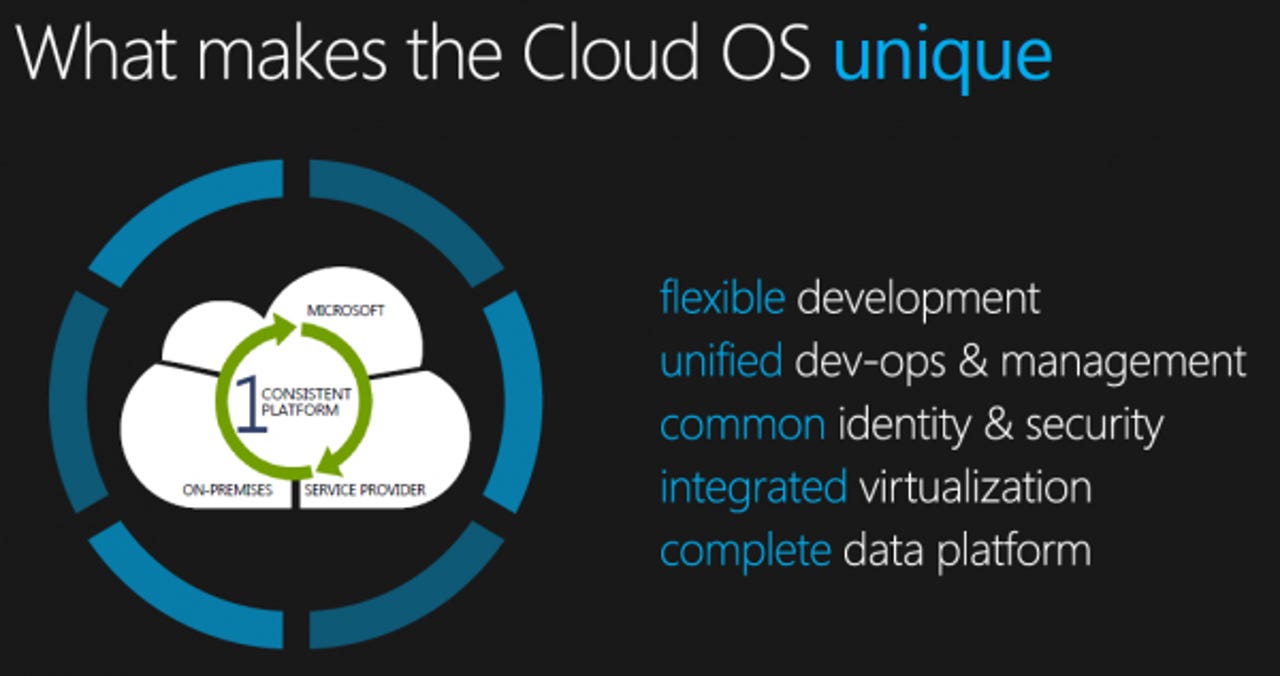Windows Server 2012 launches as cornerstone of Microsoft's 'Cloud OS'

Microsoft launched Windows Server 2012 on September 4, making the final, released-to-manufacturing versions of the product available to customers for test and purchase as of 8 am PT/11 am ET.

As part of the launch, Microsoft officials are webcasting demonstrations of some of the estimated 300 new features that are part of the product. But the overarching message of launch day is that Windows Server 2012 isn't about all the new bells and whistles in Windows Server 2012. Instead, it's about Windows Server 2012 being a key component of Microsoft's 'Cloud OS' vision and strategy -- one where the very idea of what consititues an "operating system" is morphing.
Microsoft execs have been wrestling with the best way to explain the company's approach to the cloud for the past few years. "Software plus services" gave way to "We're all in," which later gave way to Microsoft's public/private/hybrid messaging.
Since earlier this summer -- starting around the time of the Worldwide Partner Conference -- Microsoft tweaked its messaging again. The latest word is that public (Windows Azure), private (Windows Server) and hosted (partner-hosted Windows Server) are the three pieces of Microsoft's "Cloud OS" pie.
"Our Cloud OS platform is consistent across all of these things," said Michael Park, Corporate Vice President of the Windows Server and Management Marketing Team. "And Windows Server 2012 was written from the cloud, up."
Microsoft officials have been emphasizing the idea of Windows Server 2012 incorporating concepts and components from Windows Azure since September 2011, when Microsoft delivered the first public test build of Windows Server 2012.
Microsoft began to bring more symmetry to the naming of its Server and Azure components earlier this summer, rolling out an implementation of Active Directory for Azure that was meant to mirror Active Directory in Server. In June, Microsoft went a step further, bringing some of its Azure-specific technologies, like hosted virtual machines, to Windows Server, providing more commonality across the three Cloud OS elements.
"We're opening the door to every app being available on every cloud," Park said. "We've thought throught he delivery of the Cloud OS across public, private and hosed. Users will be cloud-ready from the get-go at multiple layers."
Definitions aren't all that's changing
Microsoft is doing more in an attempt to get customers accustomed to the cloud than just changing its definitions and marketing.
Three years ago, when work began in earnest on Windows Server 2012 (or, as it was known then, Windows Server 8), the Server team did things differently than it had with previous releases, said Jeffrey Snover, a Microsoft Distinguished Engineer and Lead Architect for Windows Server.
For the first year in the Windows Server 2012 planning and development process, no one on the Windows Server team was allowed to write code. It was "pens down," Snover said.
During that year, Microsoft created a number of sub-teams: The Voice of Technology team (investigating what was going on in the industry); a Voice of the Business team (investigating where the markets were headed); Voice of the Experience team (discerning pain points in data centers around the world); and Voice of the Customer team (systematically recording customer needs and requirements). The Server team also assembled its code check-in tools, quality tools and process tools during these first few months.
In late 2009, Microsoft combined its Windows Azure and Windows Server teams organizationally, creating a unified Server and Cloud division. So it's not too surprising that the overriding design and development principles for Windows Server 2012 were heavily cloud-focused.
"Automation, automation, automation was the theme we heard from the Azure team folks," Snover said. The Azure influence on Server is evident in Windows Server's focus on scalability, performance and new virtualization requirements, for example.
'
At the same time, the Server team was working ever more closely with Windows client and buying into the "One thing" (one user interface, one set of developer tools/frameworks, one common identity and commerce infrastructure) emphasis taking hold across the company. (Once Windows Server was released to manufacturing, the Server and Tools team also took a cue from Windows client organizationally, changing up titles and reporting structure to make it more like Windows client.)
The end result, Microsoft officials are hoping, is a more cohesive and compelling message around Windows Server, in terms of positioning, licensing and pricing.
"This isn't an either-or story. It's an 'and' story," Snover said. Whether a customer wants an on-premises-only single server operating system or one robust enough to handle data-center-scale networking, storage and compute, Microsoft is touting Windows Server 2012 as the right choice.